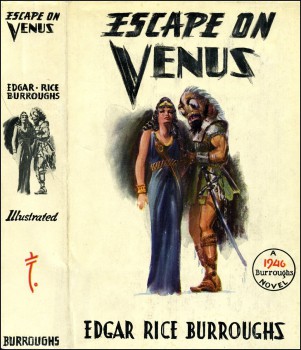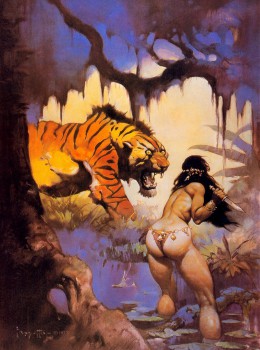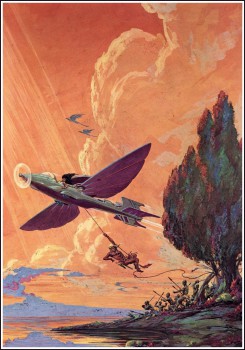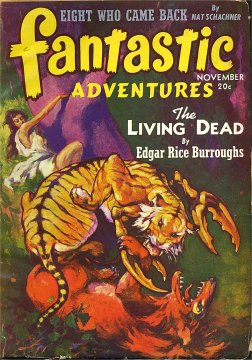Edgar Rice Burroughs’s Venus, Part 4: Escape on Venus
 I love Edgar Rice Burroughs. His novels have had an enormous influence on me as a writer and as a pulp fan. But, I must admit, sometimes he wrote … this kind of thing….
I love Edgar Rice Burroughs. His novels have had an enormous influence on me as a writer and as a pulp fan. But, I must admit, sometimes he wrote … this kind of thing….
Oh, let’s just leap into this and get it over with.
Our Saga: The adventures of one Mr. Carson Napier, former stuntman and amateur rocketeer, who tries to get to Mars and ends up on Venus, a.k.a. Amtor, instead. There he discovers a lush jungle planet of bizarre creatures and humanoids who have uncovered the secret of longevity. The planet is caught in a battle between the country of Vepaja and the tyrannical Thorists. Carson finds time during his adventuring to fall for Duare, forbidden daughter of a Vepajan king. Carson’s story covers three novels, a volume of connected novellas, and an orphaned novella.
Previous Installments: Pirates of Venus (1932), Lost on Venus (1933), Carson of Venus (1938).
Today’s Installment: Escape on Venus (1942)
The Backstory
At the start of the 1940s, Edgar Rice Burroughs decided to try an experiment with three of his properties, all of which had sailed into creative doldrums: Mars/Barsoom, Pellucidar, and Venus/Amtor. The previous Barsoom novel, Synthetic Men of Mars (1939), is one of the few stains on that otherwise superlative series. The Pellucidar novels went into a decline with 1937’s Back to the Stone Age and hit bottom with Land of Terror, which Burroughs failed to sell to any magazine when he wrote it in 1938 and waited to publish it on his own in 1944. Carson of Venus has some positives, but the Venus novels are already much lower on the quality scale of Burroughs’s work. Something wasn’t going right, and the failure to sell Land of Terror must have worried ERB.
It wasn’t just that Burroughs’s writing was in a slump — although it was — that was causing problems, but also the economic realities that were starting to kill the pulp magazines. Comic books exploded at the end of the 1930s and competed for the same young male audience that read the pulps. The magazine companies started cutting back their titles and publishing schedules; this led to reducing the number of serials they ran. Serials work well for a weekly magazine; for a monthly, not so much. Readers wanted their stories complete in each issue, and the publishers couldn’t afford to argue.
Burroughs was a savvy businessman, one the first great author-businessmen, and he chose to write a series of connected novellas in the three settings. Each of the stories could stand on its own, and then they could be strung together into a book for hardcover publication.
Burroughs planned four novellas each for the three settings, and wrote them in rotation for variety. The Barsoom group published in 1941 became Llana of Gathol (book edition 1948) and the Pellucidar set published in 1942 (although the fourth was delayed for twenty-one years) became Savage Pellucidar (book edition 1963).
The four stories that comprise Escape on Venus were originally published in Fantastic Adventures: “Slaves of the Fish Men” (March 1941), “Goddess of Fire” (July 1941), “The Living Dead” (Nov. 1941), and “War on Venus” (March 1942). The hardcover arrived faster than the other two collections, published in 1946 from ERB Inc.
Savage Pellucidar and Llana of Gathol are steps up from the low points of their respective series. Can the same be said about Escape on Venus? [Spoiler: No.]
The Story
From the Foreword:
This is the fourth story of the adventures of Carson of Venus on the Shepherd’s Star, as narrated by him telepathically to Edgar Rice Burroughs at Lanikai on the island of Oahu. It is a story complete in itself. It is not necessary even to read this foreword, unless you happen to be curious to learn how Carson navigated interplanetary space and something of the strange lands he has visited, the vast, deserted oceans he has navigated, the savage beasts he has encountered, the friends and enemies he has made, and the girl whom he won over apparently insuperable obstacles.
In other words, the story isn’t complete in itself and it is necessary to read this foreword.
 Catch-up business complete, on to the first novella: “Slaves of the Fish Men.” Carson and Duare fly back toward the nation of Korva in the flying machine anotar when a rift in the cloud layer allows the Sun to break through, creating wild weather conditions. The anotar is hurled to a strange country of people with gills and webbed toes and feet. They capture the two adventurers to take them to the city of Mypos, where they are enslaved. Carson finds an ally in another human slave, Kandar. Both of them are sold as galley slaves while Duare ends up in the harem of the king, Tyros. Carson brandishes his deadly r-ray pistol enough to scare his masters into sending him straight to Tyros’s palace, where he eventually escapes with Duare in water tunnels to get back to the anotar.
Catch-up business complete, on to the first novella: “Slaves of the Fish Men.” Carson and Duare fly back toward the nation of Korva in the flying machine anotar when a rift in the cloud layer allows the Sun to break through, creating wild weather conditions. The anotar is hurled to a strange country of people with gills and webbed toes and feet. They capture the two adventurers to take them to the city of Mypos, where they are enslaved. Carson finds an ally in another human slave, Kandar. Both of them are sold as galley slaves while Duare ends up in the harem of the king, Tyros. Carson brandishes his deadly r-ray pistol enough to scare his masters into sending him straight to Tyros’s palace, where he eventually escapes with Duare in water tunnels to get back to the anotar.
In “The Goddess of Fire” Carson flies to Kandar’s country of Japal. After Carson helps repulse an attack from the Myposans on Japal, a new enemy, the Brokols, seize him. They take him to their country and their ruling “goddess,” Loto-El-Ho-Ganja. Carson finds that this goddess, who prefers the shortened name “Loto,” is a human, and possibly has some connection to Earth. Carson gets separated from Loto when the king of the Brokols declares that she is no longer a goddess. Carson has to fight his way out of an arena, and Duare arrives just in time with the anotar to fly him away.
Once more, Carson and Duare start the next novella (“The Living Dead”) in their flying machine headed toward Korva. They almost immediately lose the propeller and crash. The Vooyorgan people of the nearby city of Voo-ad give them a glowing reception, but it is only a disguise. The king, Vik-vik-vik, paralyzes them with poison in their food and then hangs them up as displays in a gallery. Ero Shan of Hoovato, not seen since Lost on Venus, is also a living display in this museum. A Vooyorgan infatuated with Duare releases her, and Duare fast turns the tables on him. She returns with the anotar to rescue Carson and Ero Shan right as they escape from captivity.
The last novella, “War on Venus,” begins with … the exact same thing the others started with. Lost again (if someone on Venus had invented the compass, there wouldn’t have been a book series), Carson, Duare, and Ero Shan get shot out of the sky by the guns of a great army. The heroes are in the middle of a conflict between the nations of Pangan and Falsa over grazing land, and the wars are waged with massive land dreadnoughts. Duare vanishes again, etc. Will they ever get back to Korva?
The Positives
The most interesting aspect of the four novellas is the huge personality shift in Carson Napier from the earlier novels. He feels like an almost entirely new character. From a confessed incompetent, he swells into a boaster and swaggerer who is willing to violently cut down his enemies. He still admits that he’s a touch deficient in the planning department, but he is at least a more energetic hero.
Duare pulls a great stunt in the anotar, flipping it upside down to hurl out the man trying to keep her hostage from the back seat. This is the best moment for Duare in the entire series, and it teaches an important lesson about why you should always wear your seatbelt on a plane.
The rhythm of having four distinct “acts” in the story gives readers easy places to put the book aside. In other words, an upside of this book is that if you want to stop reading it, it’s easy to do.
The Negatives
Escape on Venus is one of ERB’s worst books, in a tight competition with Tarzan and the Leopard Men and Land of Terror. Even parts that seem to work end up falling to pieces as a tide of boredom overwhelms everything. A better title for the novel is Really Really Really Lost on Venus. This is a mess, making the plotless Pirates of Venus feel like a fast, exciting read. At least that book gives the illusion of forward momentum and doesn’t run in circles telling the same story four times.
 The book can’t be enjoyed as either individual novellas or a four-part episodic novel: most of it is boring, piling on variety only for the sake of variety and never making anything of its science-fiction concepts. Each episode repeats the same pattern over and over, and none of the potentially interesting ideas thrown at the reader hang around long enough to stick. The entire books feels as if Burroughs was making it up as he went along, and at the end got so bored that he dashed out a finale just to be done with it.
The book can’t be enjoyed as either individual novellas or a four-part episodic novel: most of it is boring, piling on variety only for the sake of variety and never making anything of its science-fiction concepts. Each episode repeats the same pattern over and over, and none of the potentially interesting ideas thrown at the reader hang around long enough to stick. The entire books feels as if Burroughs was making it up as he went along, and at the end got so bored that he dashed out a finale just to be done with it.
The whole “argument” listed above is almost perfunctory. I can sum up the whole plot in two sentences: “Carson and Duare try to get to Korva, but continually land or crash their anotar in the middle of dangerous civilizations. After some action, they escape and repeat the process.”
Escape on Venus is just “a bunch of stuff”; each bit of “stuff” shows up, performs a function without any sense of excitement or tension, and then disappears down the memory hole. The Myposan fish men begin as major enemies, then pop up in the second novella as if to continue that role, only to vanish when the Brokols show up with no warning at all in the middle of the episode. The Brokols last a few chapters, and then Carson makes a tensionless escape, and the anotar crashes in front of another weird city with a strange civilization, et cetera.
The last novella promises a “war,” but where Burroughs could have taken the great concept of land dreadnoughts and put them in the context of some established civilizations (why not have a Vepaja vs. Thora showdown, fulfilling the promise of the first novel?) he instead invents a pack of new cultures and it is impossible to care about any of the action. At this point, the repetitive storyline will have forced all but readers who have to write a review of Escape on Venus to throw the book aside and get some ironing done. The conclusion is literally the characters just walking home.
Carson retains a maddening inaction from his older characterization; he still lacks the important qualities of a protagonist. He bluffs, he kills, he brags, but still makes few efforts to do anything. Instead of trying to bash his way through the fish men when they enslave him, he’s content to disintegrate a few with his r-ray gun and remain a slave. Come on, Carson! If you’ve got the power to beat these jerks, use it! It’s like he wants to act like John Carter, without acting on John Carter’s attitude.
Above all, Carson is a jerk throughout. He sees each adversary as a mindless inferior, and his retorts to his enemies make him sound like a petulant bully, not a hero. When placed in an arena fight — a classic ERB situation — Carson simply blasts everybody away with his r-ray, resulting in the most boring arena battle in the author’s canon.
Continuing on a theme, a coherent Venusian environment gets junked for new nations and races that have no connection with anything seen before. The fish men of Mypos and the tree-growing Brokols might have occurred in any story, not specifically a Venusian one. The fish men might as well have no connection to fish, since Burroughs does nothing remarkable with them as an aquatic race. They swim better than humans, have gills and webbing, and their children start as fish in pools, but nothing else distinguishes them from humans. The fish-spawn idea comes across as patently ludicrous, since the adults are still ninety-percent human. The Brokols make no sense as an arboreally grown species; they act like standard pulp barbarians. The Vooyorgans are the best of the new races, but the idea of them asexually reproducing through splitting down the middle is a bit far-out for something as short as a novella. The Pangans and Falsans are just humans with big tanks who get in Carson’s way for a few chapters.
 The supporting cast is enormous … and utterly disposable. Carson rips through a series of allies with similar-sounding names, and they drop in and out of the story while having zero impact. Characters from the past books show up, as if ERB thought this might tie all the series together, but they get the same perfunctory treatment. The goddess Loto and her mysterious Earth-link is the only figure who registers at all, and the mystery around her connection to Earth is disposed of without consequences.
The supporting cast is enormous … and utterly disposable. Carson rips through a series of allies with similar-sounding names, and they drop in and out of the story while having zero impact. Characters from the past books show up, as if ERB thought this might tie all the series together, but they get the same perfunctory treatment. The goddess Loto and her mysterious Earth-link is the only figure who registers at all, and the mystery around her connection to Earth is disposed of without consequences.
Damn, but I got sick of the anotar at this point in the series. No matter where Carson lands his homemade plane, nobody disturbs it, damages it, or steals it, so he can locate it again and fly off to the next scheduled adventure. This has gone on since the end of Lost on Venus and I wish Burroughs had come up with a new invention and a different way to move Carson and Duare from location to location. Why duck the drama of having an enemy either break it or steal it? At the point Carson and Duare finally decide they aren’t going to land and get in yet more trouble, the propeller promptly breaks and forces them to do they whole shtick over again. (I did, however, laugh out loud of the absurdity of the timing of this.)
In a bizarre move, the POV switches abruptly from first person from Carson’s perspective to third person from Duare’s in the middle of “The Living Dead.” This reads like a quick fix for a storytelling problem, but since the whole series to this point has been in first person, it’s disconcerting and throws off the entire novella. You have to develop this kind of POV swap, not throw it out because you can’t solve a plot problem.
The big collective downside from all of this is the cardinal sin no fiction writer should commit: Boredom. If Escape on Venus was the first Edgar Rice Burroughs book you chose to read (although I can’t see a situation where that would happen) you would never want to read anything else from him again.
Craziest Bit of Burroughsian Writing: “You don’t think I’m familiar with California; you don’t think I’ve ever been to California. So! You don’t think I’ve ever been to California, when I say I have. What do you mean, coming here and looking for trouble!” The book needs more of this prose weirdness.
Most Triumphantly Stupid Carson Napier Moment: Killing everything in sight with his r-ray pistol, but still not using the weapon to escape.
Best Monster: The bird-creature guypals — only because of their hilarious name.
Most Uncomfortable Moment for the Modern Reader: No modern reader will get through this unless he’s named “Ryan Harvey” and promised on a website to read and review all the ERB Venus novels.
Carson Summarizes the Book in One Sentence: “The Myposans were not pleasant people,” I said; “neither were the Brokols, nor the Vooyotgans; but I lived through captivity with them, and I escaped.”
Should ERB have continued the series? Are you kidding? Enough of this.
Next Up: “The Wizard of Venus”
Ryan Harvey is one of the original bloggers for Black Gate, starting in 2008. He received the Writers of the Future Award for his short story “An Acolyte of Black Spires,” and his stories “The Sorrowless Thief” and “Stand at Dubun-Geb” are available in Black Gate online fiction. A further Ahn-Tarqa adventure, “Farewell to Tyrn”, is currently available as an e-book. Ryan lives in Los Angeles. Occasionally, people ask him to talk about Edgar Rice Burroughs or Godzilla in interviews.
[…] (Black Gate) Savage Pellucidar:–– “I’ve told this tale before with Escape on Venus and Llana of Gathol, the sister works of Savage Pellucidar, but once more won’t hurt. At the […]